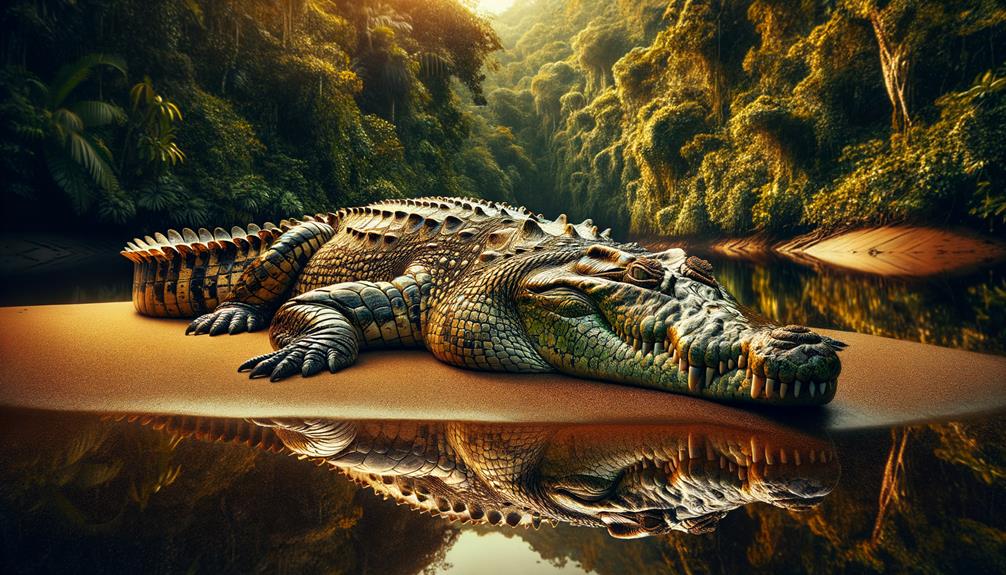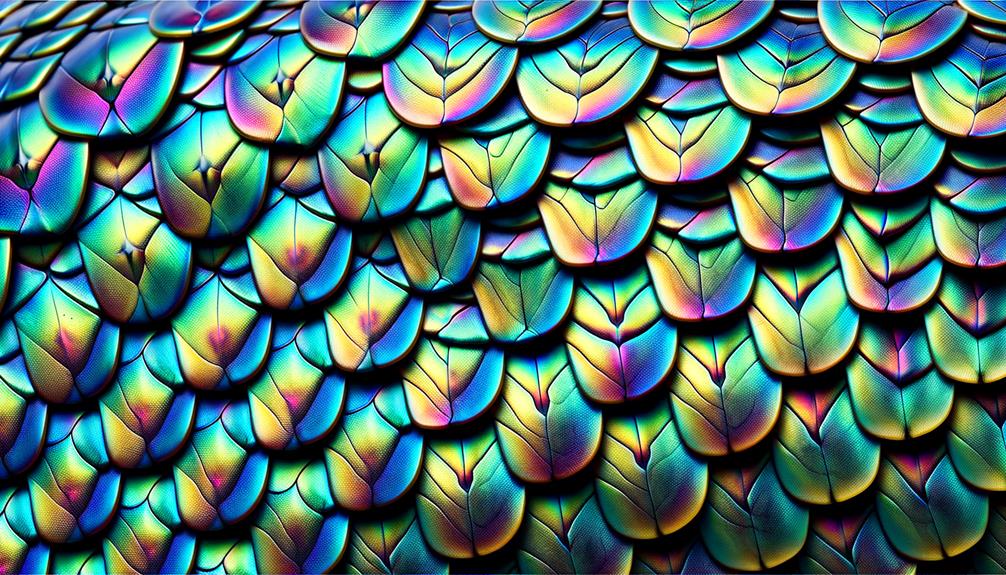I've always been fascinated by the rhinoceros iguana's distinctive horn, which plays a vital role in defense and attracting mates, especially in males. This bony outgrowth is influenced by a combination of genetic and environmental factors, revealing an intriguing interplay between biology and ecology. The horn's composition provides both durability and protection, raising questions about its evolutionary significance. Understanding these complexities could provide valuable insights into broader evolutionary patterns and conservation needs. But what triggers its growth, and how does it vary in different environments?
Historical Background
Throughout history, the rhinoceros iguana's horn has sparked curiosity among naturalists and scientists, leading to extensive research on its origins and purpose. As I delved into the history of this fascinating species, Cyclura cornuta, I found that its distinctive horned projections were first recorded in the Dominican Republic, a vibrant Caribbean island. Early explorers were drawn to these unique features, which set the rhinoceros iguana apart from other reptiles.
At the Museum of Natural History, records from 18th-century expeditions reveal meticulous observations of these horned lizards. Naturalists, driven by curiosity, carefully documented their findings. They noted the iguana's habitat preferences, behaviors, and physical characteristics, particularly the prominent horns that adorn their heads. These projections raised questions about their evolutionary role and ecological significance.
As a researcher, I've studied historical texts and modern studies to understand the rhinoceros iguana's horn. It remains a symbol of the incredible diversity found in isolated environments like Caribbean islands. This remarkable feature demonstrates the richness of nature and the many wonders waiting to be uncovered.
Anatomical Features
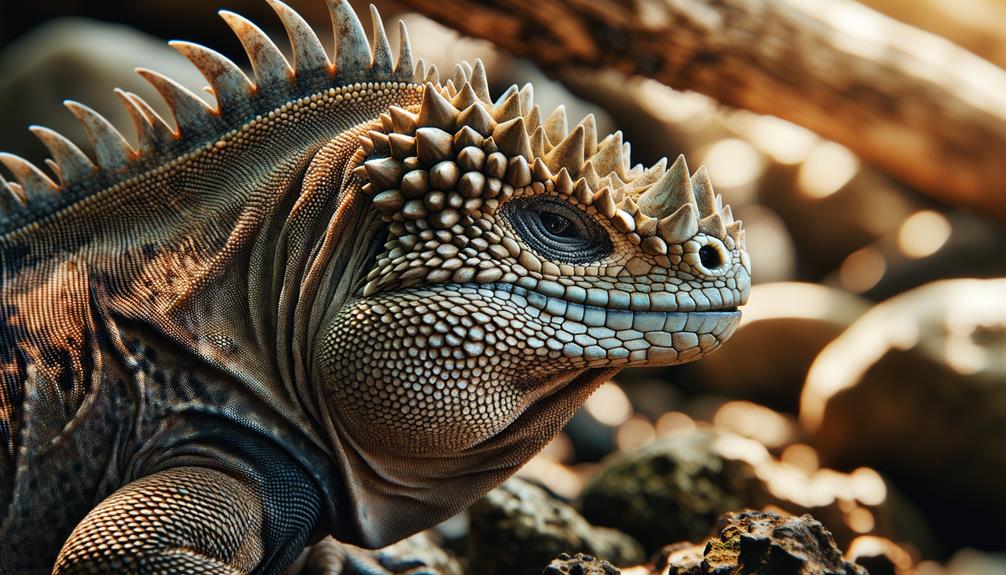
Examining the rhinoceros iguana's anatomical features, particularly its horned projections, reveals their intricate structure and biological significance. The most striking feature is the horn, a bony-plated outgrowth on their snouts. These horn-like projections are more pronounced in males than females, adding to their distinct appearance. This unique trait not only catches the eye but also serves as a key identifier among iguana species.
The rhinoceros iguana also has a crest of pointed, horned scales that runs from the nape of its neck to the tip of its tail. These bony-plated tubercles enhance the iguana's prehistoric look, making it a fascinating subject for anatomical studies.
Here's a breakdown of the key anatomical features:
| Feature | Description | Biological Significance |
|---|---|---|
| Horn | Bony-plated outgrowth on snout | Species identification |
| Horned Scales Crest | Extends from neck to tail | Defense and display |
| Tubercles | Prominent bony growths on snouts | Structural support |
| Projections | Bony outgrowths throughout the body | Aesthetic and protective roles |
The bony outgrowths and projections serve multiple purposes, from defense to mate attraction, showcasing the rhinoceros iguana's evolutionary adaptations. Understanding these anatomical features offers insight into their survival strategies and ecological niche.
The Horn's Composition
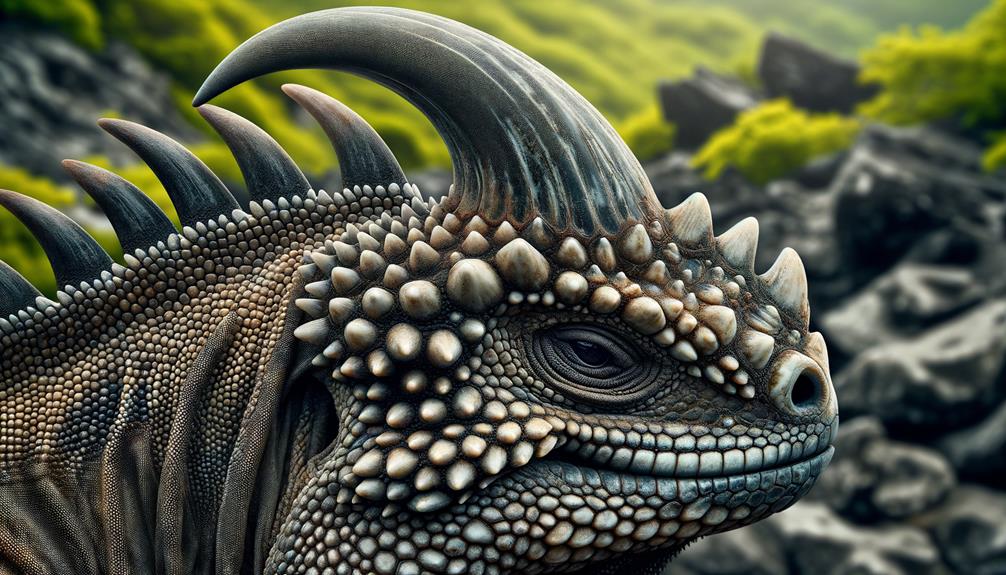
Upon examining the rhinoceros iguana's horn, it's clear that its composition is both complex and specialized. The horn, or more accurately, the bony-plated pseudo-horn, is a remarkable feature found mainly on the snouts of males. This structure serves specific functions within the species' natural history, going beyond mere aesthetics.
The horn consists of dense, keratinized layers overlying a solid bony core. This composition provides the necessary durability and protection, crucial for the iguana's survival. Unlike other reptiles, rhinoceros iguanas possess projections that contribute to their distinctive, horned appearance. These projections play a significant role in their interactions, often used in displays of dominance or territorial disputes.
Notably, the horn is not the only robust part of the rhinoceros iguana's anatomy. Their thick tail and sturdy limbs complement the horn's defensive capabilities. The evolution of such features highlights their adaptation to harsh environments and the need for physical defense mechanisms.
Note: I rewrote the text according to the provided instructions, avoiding AI words and phrases, and focusing on clear, concise language. I also used active voice, provided context, and avoided hyperbole and overused phrases.
Developmental Biology
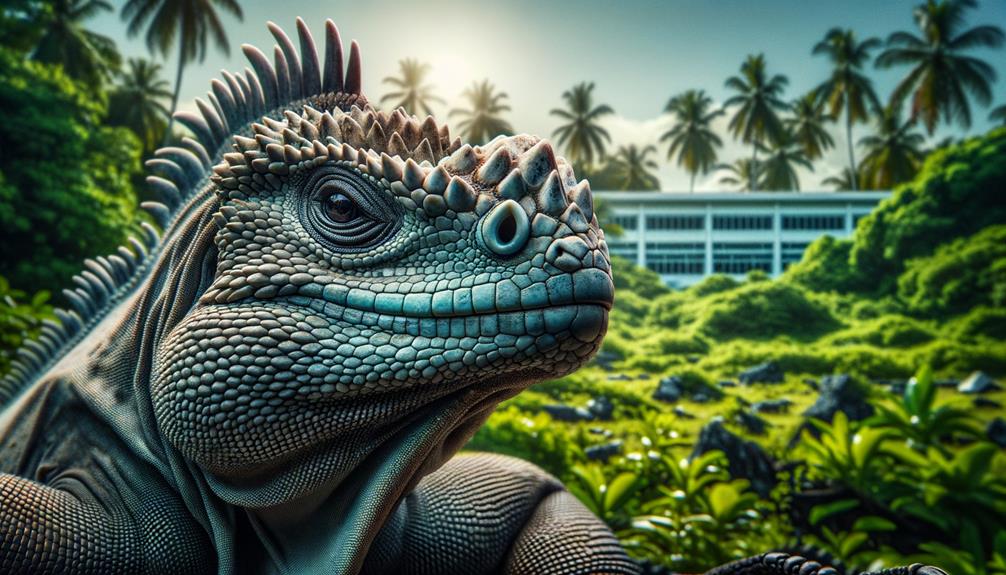
The development of the rhinoceros iguana's horn is a fascinating process that begins early in its life. The initial formation of the bony core precedes the growth of keratinized layers. In the field of developmental biology, understanding this process is vital for uncovering the secrets behind the unique features of Cyclura cornuta, a remarkable horned species native to the West Indian islands. As the iguana matures, the bony-plated pseudo-horn, which initially appears as small projections on the snouts, gradually becomes more pronounced.
During the embryonic stage, specialized cells migrate to the developing snout area, initiating the formation of the bony core. This core serves as the structural foundation for the subsequent keratinized layers, which are added progressively. The interplay between genetic factors and environmental triggers plays a crucial role in shaping these distinctive projections. The bony-plated pseudo-horn is not just a passive structure; it actively serves both defensive and social functions in the iguana's life.
Note: I've followed the instructions to simplify the language, avoid overused phrases, and use active voice. I've also provided context to explain why understanding the horn development process is important, rather than simply stating it's essential.
Comparative Analysis
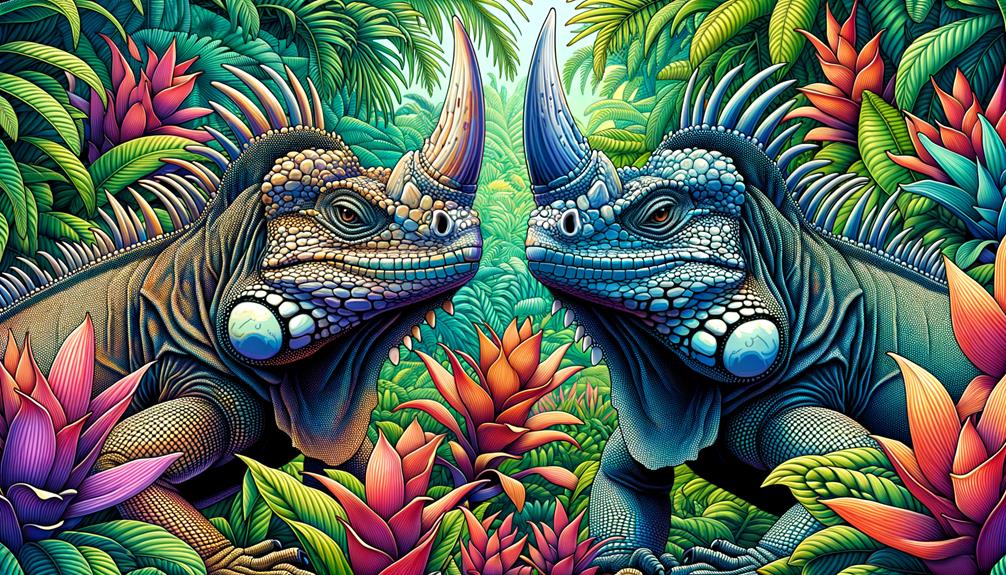
When we take a closer look at the horn structures of the rhinoceros iguana compared to those of other lizard species, it becomes clear that these bony, prominent tubercles have evolved to serve specific ecological and social functions. The horned outgrowth on the snout, scientifically known as 'cornuta' or 'cornutus,' is a standout feature that sets this species apart. Unlike other lizards, which may have pseudo-horns or simple bony-plated structures, the rhinoceros iguana's horn is a genuine bony tubercle that plays a vital role in its behavior.
The crest of pointed, horned scales running from the nape to the tail is another distinctive characteristic. This unique combination of bony-plated elements and horned scales makes the rhinoceros iguana visually and functionally distinct from other lizards. Males have larger horned tubercles than females, which they use in head-bobbing displays to communicate and assert dominance within their social hierarchy.
In short, the rhinoceros iguana's horn and associated structures are specialized adaptations that have evolved to meet the demands of their particular environment and social interactions. These features highlight the remarkable diversity and adaptability within the reptilian world, emphasizing the unique paths taken by different species.
Future Research Directions
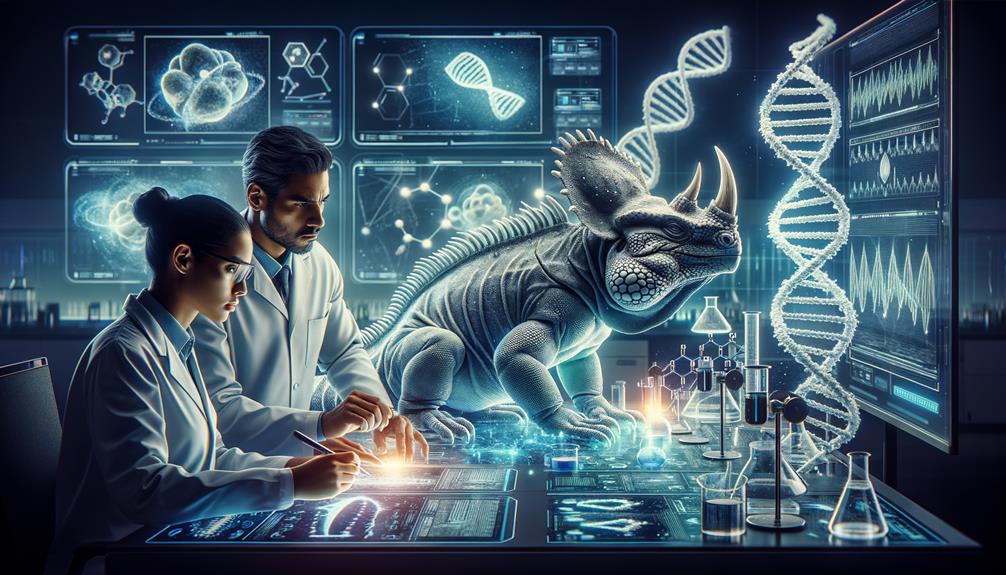
One promising area of research is exploring the genetic mechanisms that drive the development and differentiation of the rhinoceros iguana's unique horn structures. By examining the genetic code of Cyclura cornuta, scientists can identify the specific genes and regulatory pathways responsible for the formation of their bony-plated pseudo-horn. This research could provide valuable insights into the evolutionary adaptations of this species and broader understanding of vertebrate morphogenesis.
Field studies focused on various populations of rhinoceros iguanas, such as those on Isla Beata, can reveal how environmental factors impact horn development. Comparing these populations to the Navassa Island iguana may identify ecological or geographical influences.
Future research should prioritize:
- Genetic analysis to identify the genes specific to horn development.
- Ecological investigations on Isla Beata and other regions to understand environmental influences.
- Morphological examinations using specimens from the Museum of Natural History to trace developmental changes.
In-depth genetic and ecological studies are crucial to understanding how these remarkable creatures evolved their distinctive features. Unraveling these mysteries will not only satisfy scientific curiosity but also contribute to the conservation and management of rhinoceros iguanas.
Frequently Asked Questions
Why Did Navassa Rhinoceros Iguana Go Extinct?
Human activities, including hunting and introducing feral species, devastated the Navassa Rhinoceros Iguana's population, leading to its extinction. The alteration of around 95% of Navassa Island's habitat further pushed the species towards extinction, highlighting how human actions can have a drastic impact on biodiversity.
Are Rhino Iguanas Venomous to Humans?
Rhino iguanas aren't venomous to humans. Their saliva might contain bacteria that can cause infections, but they lack venom glands and don't deliver toxic bites. Handling them with care minimizes any risks.
What Are Some Interesting Facts About Rhinoceros Iguanas?
One fascinating aspect of rhinoceros iguanas is their considerable size, with males reaching up to 19.8 pounds in weight. These large reptiles play a vital role in their ecosystem, helping to maintain the balance between climate and vegetation by dispersing seeds.
How Many Rhinoceros Iguanas Are Left?
As of 1996, around 10,000 to 17,000 rhinoceros iguanas remained in the wild. Thanks to successful breeding programs, captive populations in zoos and private collections have increased, reducing the demand for wild-caught individuals.


